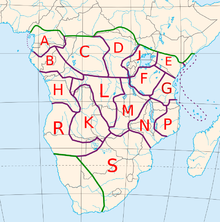 Approximate distribution of Bantu peoples divided into zones according to the Guthrie classification of Bantu languages | |
| Total population | |
|---|---|
| 350 million | |
| Regions with significant populations | |
| Languages | |
| Bantu languages (over 535) | |
| Religion | |
| Mostly Christianity (Catholic and Protestant) Minorities: Islam and traditional Bantu religions |
The Bantu peoples are an indigenous ethnolinguistic grouping of approximately 400 distinct native African ethnic groups who speak Bantu languages. The languages are native to countries spread over a vast area from West Africa, to Central Africa, Southeast Africa and into Southern Africa. Bantu people also inhabit southern areas of Northeast African states.[1][2]
There are several hundred Bantu languages. Depending on the definition of "language" or "dialect", it is estimated that there are between 440 and 680 distinct languages.[3] The total number of speakers is in the hundreds of millions, ranging at roughly 350 million in the mid-2010s (roughly 30% of the population of Africa, or roughly 5% of the total world population).[4] About 60 million speakers (2015), divided into some 200 ethnic or tribal groups, are found in the Democratic Republic of the Congo alone.
The larger of the individual Bantu groups have populations of several million, e.g.the large majority of West Africa, notably the most populous African nation Nigeria, Rwanda, Tanzania, Uganda, Kenya, Burundi (25 million), the Baganda[5] people of Uganda (5.5 million as of 2014), the Shona of Zimbabwe (17.6 million as of 2020), the Zulu of South Africa (14.2 million as of 2016[update]), the Luba of the Democratic Republic of the Congo (28.8 million as of 2010[update]), the Sukuma of Tanzania (10.2 million as of 2016[update]), the Kikuyu of Kenya (8.1 million as of 2019[update]), the Xhosa people of Southern Africa (9.6 million as of 2011), batswana of Southern Africa (8.2 Million as of 2020) and the Pedi of South Africa (7 million as of 2018).
- ^ "Bantu people (Central, East, Southern Africa)". Africa EENI Global Business School. Archived from the original on 29 April 2023. Retrieved 21 August 2022.
- ^ Butt, John J. (2006). The Greenwood Dictionary of World History. Greenwood Publishing Group. p. 39. ISBN 978-0-313-32765-0.
- ^ "Guthrie (1967–71) names some 440 Bantu 'varieties', Grimes (2000) has 501 (minus a few 'extinct' or 'almost extinct', Bastin et al. (1999) have 542, Maho (this volume) has some 660, and Mann et al. (1987) have c. 680." Derek Nurse, 2006, "Bantu Languages", in the Encyclopedia of Language and Linguistics, p. 2. Ethnologue's report for Southern Bantoid Archived 21 January 2022 at the Wayback Machine lists a total of 680 languages. The count includes 13 Mbam languages which are not always included under "Narrow Bantu".
- ^ Total population cannot be established with any accuracy due to the unavailability of precise census data from Sub-Saharan Africa. A number just above 200 million was cited in the early 2000s (see Niger-Congo languages: subgroups and numbers of speakers for a 2007 compilation of data from SIL Ethnologue, citing 210 million). Population estimates for West-Central Africa were recognized as significantly too low by the United Nations Department of Economic and Social Affairs in 2015 ("World Population Prospects: The 2016 Revision – Key Findings and Advance Tables" (PDF). United Nations Department of Economic and Social Affairs, Population Division. July 2016. Archived from the original (PDF) on 26 June 2019. Retrieved 26 June 2017.). Population growth in Central-West Africa as of 2015[update] is estimated at between 2.5% and 2.8% p.a., for an annual increase of the Bantu population by about 8 to 10 million.
- ^ Roscoe, John (2011). The Baganda an Account of Their Native Customs and Beliefs. Cambridge Univ Pr. ISBN 978-1-108-03139-4. OCLC 714729287.